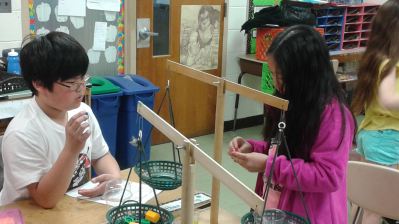Program Options for English Language Learners/Multilingual Learners
Bilingual Education (BE)
Transitional Bilingual Education Program
Transitional Bilingual Education (TBE) programs offer students of the same home language the opportunity to learn to speak, understand, read, and write in English while continuing to learn academic content in their home language. The students’ home language is used to help them progress academically in all content areas while they acquire English.
The goal of a TBE Program is to provide students with the opportunity to transition to a monolingual English classroom setting without additional supports once they reach proficiency. Even though the amount of English instruction students receive will increase over time, in a TBE program, there will always be home language instruction/supports allowing students the opportunity to develop bilingually.
Dual Language Programs
Dual Language (DL) programs seek to offer students the opportunity to become bilingual, biliterate, and bicultural while improving their academic ability. In the majority of dual language programs, the students receive half of their instruction in their primary or home language, and the remainder of their instruction in the target language, the language that they are learning. However, there are other time configurations that exist. For example in a 90% to 10% model, a greater percentage of the instruction is in the target language other than English and decrease over time until reaching 50% to 50%.
Students learn to speak, read, and write in two languages, and also learn about other cultures while developing strong self-esteem and diverse language skills.
One-Way Dual Language Program
In the one-way Dual Language program model, students who come from the same primary or home language and or background have the opportunity to be bilingual or multilingual. The teacher or teachers provide instruction in both English and the primary or home language simultaneously.
Two Way Dual Language Program
The two-way Dual Language program includes both native English speakers and ELLs. The teacher or teachers provide instruction in both English and the home/primary language. In the majority of Dual Language Programs, the students receive half of their instruction in their home/primary language and the remainder of their instruction in the target language. Depending upon the model, the percentages of English and home/target language instruction will vary. For example, in a 90%-10% model, a greater percentage of the instruction is in the target language other than English and increases over time until reaching 50%-50%. The goal of these programs is for students to develop literacy and proficiency in English and in the home/target language (the second language that is being acquired/learned).
English as a New Language (ENL)
Instruction in this program, formerly known as English as a Second Language (ESL), emphasizes English language acquisition. In an ENL program, language arts and content-area instruction are taught in English using specific ENL instructional strategies. Some content area classes are Integrated ENL classes. Students receive core content area and English language development instruction, including the use of the home/primary language as support and appropriate ELL instructional supports to enrich comprehension. Integrated ENL classes are taught by a teacher dually certified in the content area and ENL or are co-taught by a certified content area teacher and a certified ENL teacher. In a Stand-alone ENL class, students receive English language development instruction taught by a NYS-certified teacher of English to Speakers of Other Languages (ESOL) in order to acquire the English language needed for success in core content areas. This program typically serves ELL students from many different home/primary language backgrounds whose only common language is English and therefore cannot participate in a bilingual program.
The Office of Bilingual Education has produced a whiteboard animation video, translated into eight languages, that provides parents with information about these program options. This video must be shown at parent orientation sessions and can also provide educators with information about these program models.
The New York State Seal of Biliteracy
The New York State Seal of Biliteracy was approved by the Board of Regents along with the criteria required to demonstrate proficiency in two or more languages. The Board’s approval is an endorsement of language acquisition within our state’s schools and communities and a call to districts to encourage and celebrate language learning. Furthermore, it is an opportunity for teachers to develop rigorous and stimulating programs so that all students can demonstrate the level of proficiency that will earn them the NYS Seal of Biliteracy. We are delighted to introduce this new initiative and will work with administrations and educators throughout the state to help them create their programs. Resources for Implementation include:
- NYSSB Handbook which includes Q/A guidance document, forms, regents item, glossary and resource links
- Forms: District Notification Form
- Seal Image Request Form and End-of-Year Data Form
- Professional Development on the implementation of the Seal of Biliteracy






